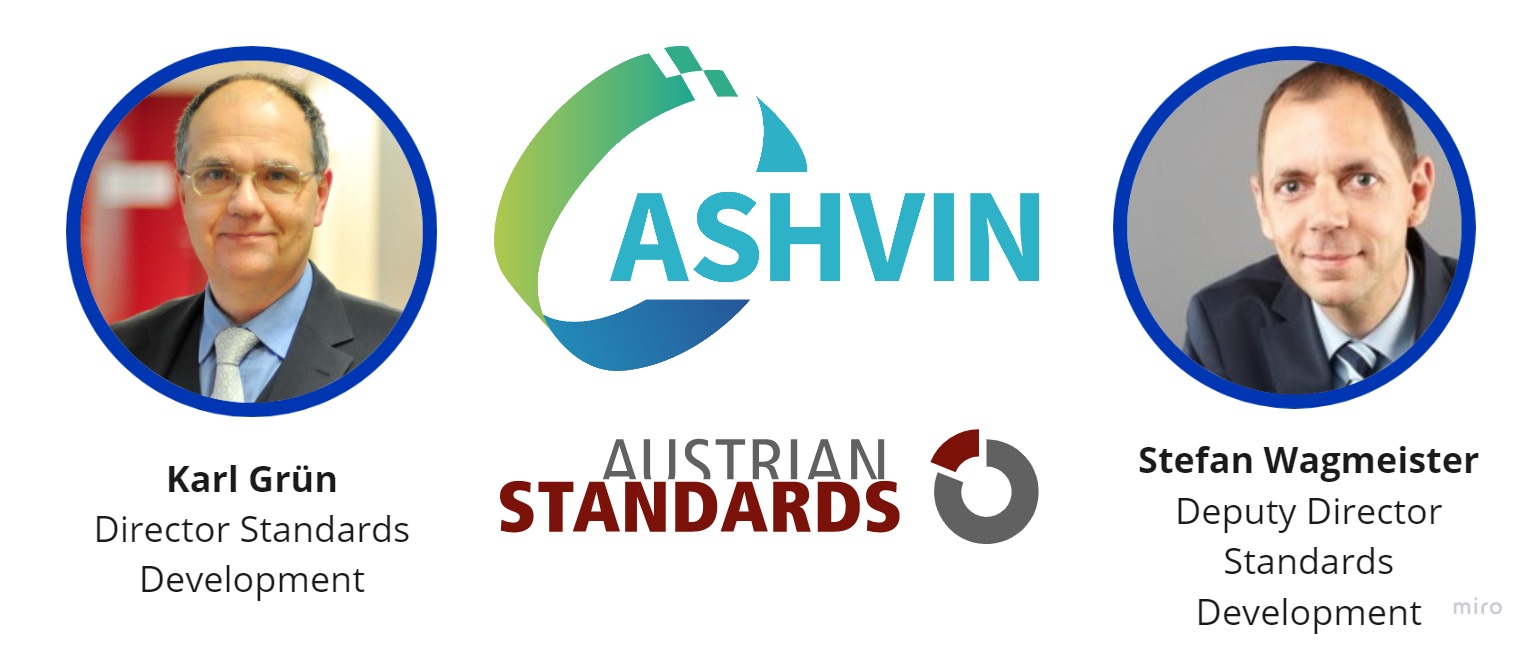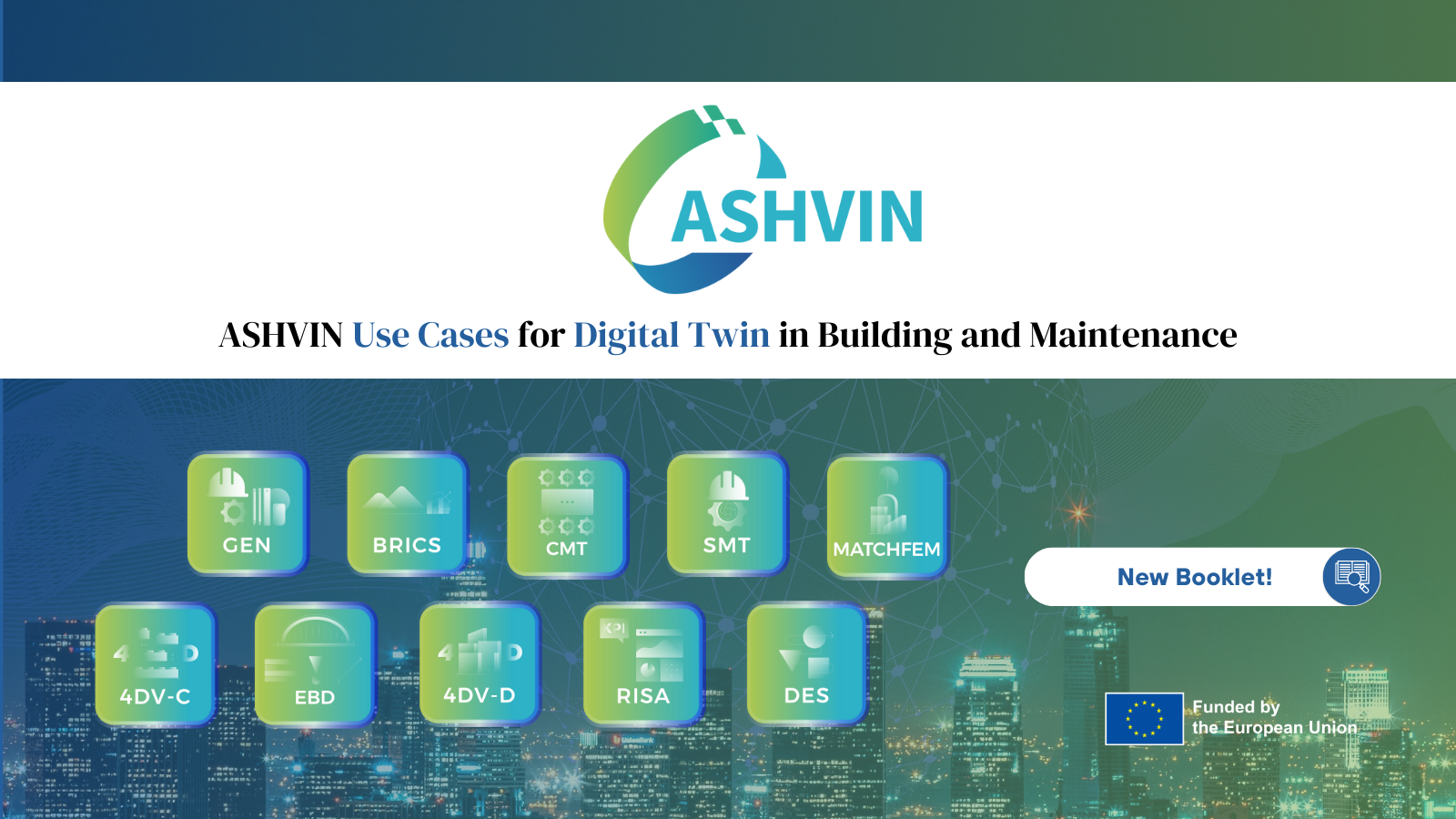The ASHVIN project develops a digital twin solution for the construction industry to boost productivity and safety. To foster the digitalisation of the construction industry, ASHVIN also develops a global standard related to the deployment of digital twin technologies. The standardisation work aims to increase the systems’ interoperability and align the work processes among stakeholders. Austrian Standards leads the work package on social innovation and standardisation, looking into the long-term adoption of the ASHVIN solution by its target end-users.
Exploitation Workshop to Present Standardisation Roadmap
On the 6th of February, the ASHVIN project hosted a workshop for the Advisory Board members on standardisation. All 6 advisory board members were invited to participate in the session. They are:
- Salla Eckhardt , Senior Vice president at OAC SVCS Services based in Seattle, USA
- Prof. Carl Haas, Chair and Professor of the Department of Civil and Environmental Engineering, the University of Waterloo, Canada.
- Dr Sebnem Düzgün, Chair and Professor from Colorado School of Mines, USA
- Prof.Martin Fischer , Professor at the Department of Civil and Environmental Engineering, Center of Integrated Facility, Stanford University, USA
- Dr Heng LI , Chair Professor of Construction Informatics at Hong Kong Polytechnic University, Hong Kong
- Mathieu Boda, Business Developer and Expert in Digital Twins, France
Salla Eckhardt was the only advisory board member present at the standardisation workshop. From Austrian Standards, Karl Grün and Stefan Wagmeister hosted the session presenting the research carried out by the ASHVIN team to identify the standardisation needs related to the deployment of the digital twin in the construction sector. The workshop’s goal was to obtain feedback and recommendations from our top-notch experts, ensuring that the engaged standardisation process meets the needs of the related research sector and industry.

Status of the Standardisation Task
Austrian Standards presented the objective of the standardisation work within the ASHIN project and, foremost, the results until February 2023, six months before the end of the project. The final goal is to propose and develop an international ICT standard that is used within 200 projects related to digital twins. However, developing a standard is a challenging process that engages all relevant stakeholders and reaches a consensus for finding practical and technical solutions for users’ needs. This process can take even years. That’s why there will not be a well-established standard at the end of the project in September 2023. ASHVIN will propose items for further standardisation, propose to standardisation committees and conduct a study of the most frequently used standards in the digital twin sector.
Needs for Standards in Digital Twin
Resulting of research of needs from the ASHVIN partners, ASHVIN has identified three main ideas for future standardisation:
- Using UAVs/Drones for the inspection of buildings/construction sites
- Monitoring of works at the construction site
- Load tests of bridges as the ideal episode for the digital birth of the asset
These three ideas are developed further, and linked with the related partners and standardisation organisations. For instance, Associate Professor Rolando Cachon from the UPC, researching the load test of bridges with digital twin tools, supports Austrian Standards to develop the related standardisation proposal, represents ASHVIN at the IABMAS, International Association for Bridge Maintenance and Safety and participates in CEN/TC 442/WG 9 , Digital twins in the built environment.
Feedback and Future Stakes about the Digital Truth
“How will the standardisation take the approach of being more machine-readable”?, asked Salla Eckhardt. She underlined the importance of systems being able to collect and process machine-readable data automatically without human intervention, which increases the risk of errors. Salla recommended the ASHVIN project to investigate standardisation that fosters automatic data processing with interoperable databases. In line with this, she underlined the importance of managing the system’s cybersecurity, meaning who can access and which data.
“Standardisation could support by giving rules on how to define machine-readable data for different uses cases (e. g., maintenance of assets). One of our standardisation ideas (Load tests of bridges as the ideal episode for the digital birth of the asset) should address this issue.”, agreed Stefan Wagmeister.
“Indeed, cybersecurity is a critical point”, replied Karl Grün, and he continued “, We need to avoid future scenarios where we read from the news that a bridge is hacked due to issues in data processing”.

Also, more trustworthy standards can support the reduction of manual work by humans in the data collection and processing, more the target end-users can be interested in deploying the technical innovations, such as ASHVIN. However, as selected construction site managers, the target users should be trained not only to deploy the digital solution but, foremost, in data management and privacy. In line, ASHVIN has the social dimension in research analysing how to convince people to use the digital solution. This is where we can learn from mechanical engineering in construction. In the end, the end-users want to understand clearly “What’s in for me?” as Salla Eckhardt and Karl Grün pointed out.
In the best scenario, with standards of future digital solutions, standardised data is harmoniously used in the design, construction and maintenance of buildings and infrastructures. This can mitigate or prevent risks, errors and accidents, which enables engineering to save society from future catastrophes and even to save lives.





